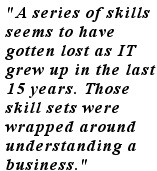The NCES report states about 287,278 students received a bachelor’s degree in math or the natural sciences or computer sciences/engineering in the 2011-12 school year. This may seem like a lot, but in fact, it’s just 16 percent of all degrees conferred that year. When compared to the combined 949,565 degrees awarded across humanities (295,221), social and behavioral science (287,529) and business (366,815) in 2012, it withers on the vine.
What is it that keeps more students from earning a degree in technical fields like computer science and mathematics? Jacob Klein, CEO and co-founder of Motion Math, an educational mobile iOS and Android game developer, thinks it has something to do with the way the education system engages and immerses students in mathematical topics.
Hooking them while they’re young
 Even though his first job was as a video producer, math was a subject that Klein felt an affinity for as a young man.
Even though his first job was as a video producer, math was a subject that Klein felt an affinity for as a young man.
“I remember some of the manipulatives that I had as a kid, like colored fraction blocks, and also some of the games,” he said. “I also personally just loved math structure, and I’ve had some fantastic teachers who would challenge me in math.”
Klein was lucky that he was able to stoke the flames of his love for numbers. For children ages 6 and younger, it’s crucial to generate an interest in mathematical topics, according to a position statement from the National Council of Teachers of Mathematics, because it helps them develop curiosity, imagination, persistence and confidence in their ability to solve problems.
By not stimulating that early interest, there could be potential mathematicians lost to other paths. Based on his own love of math and the fact that there weren’t many math-learning games for children, Klein set about creating Motion Math along with co-founder Gabriel Aduato. Motion Math’s games are all built around K-6 math concepts. Part of the reason for this is because “younger students are just more open and eager to learn,” according to Klein. “They also don’t see a contradiction between learning math while playing a game.”
Developing for Android, developing for iOS
The heart of Motion Math’s development is in iOS, which is where most of their catalog is available. As of the time of this article two of the company’s games, “Motion Math: Hungry Fish” and “Motion Math: Fractions!” are also up on the Google Play store.
Educational value aside, the decision to focus on iOS with Android as a secondary priority makes sense. Despite Android having an overwhelming 84.7 percent of global smartphone market share according to IDC, iOS collects 14 percent of its revenue from apps that require either upfront payment or upfront payment with additional microtransactions (like non-free-to-play games. In contrast, a 2014 Venturebeat article found that Android only brings in 6 percent revenue from those app categories.
Motion Math’s FAQ page states that porting additional games to Android will be prioritized based on the amount of people playing the games it already has on that OS.
Creating Motion Math
One of Motion Math’s recent iOS games, “Motion Math: Pizza,” lets users run their own pizzeria. It aims to teach children about the economics of running a business: when to increase their stock in order to take advantage of deals with suppliers, how to price a product to maximize profits without driving away customers and how to work a cash register.
Another iOS game, Motion Math: Match asks the player to match different tiles that go together. It may sound simple, but it’s not just about matching the visuals — players have to figure out what the tiles mean. One might show the number 3, while another shows 5-2. These tiles match, but children will have to use their math skills to figure that out. As the game progresses, matching the tiles becomes harder and players are given less time to figure out which tiles go together.
So far the response to the games has been positive, especially from educators.
“Teachers tell us they appreciate the challenging and exploratory design of our games,” Klein said, “and that’s exactly what we’re aiming for, not just pleasant practice. We want kids to discover important math concepts through play.”
Building for the future
As Klein thinks about preparing young minds for the future of math, he doesn’t have any current plans to develop any games going beyond K-6 topics.
“There are so many more concepts that elementary schools students struggle with that we think could be addressed with games,” he said. “So we’re perfectly content to keep our focus on K-6. Long term, we’d love to do more games for middle and high school, but for now it’s all about elementary math concepts.”
Success for Motion Math games can mean success for young students in the classroom and in building confidence in their math abilities. This may lead to more math majors graduating with degrees in the field.
Sources:
“Bachelor’s, master’s, and doctor’s degrees conferred by postsecondary institutions, by field of study: Selected years, 1970-71 through 2011-12,” National Center for Education Statistics,
http://nces.ed.gov/programs/digest/d13/tables/dt13_318.20.asp
“Early Childhood Mathematics: Promoting Good Beginnings,” National Association for the Education of Young Children, August 25, 2014, https://www.naeyc.org/files/naeyc/file/positions/psmath.pdf
“IDC: Smartphone OS Market Share 2014, 2013, 2012, and 2011,” IDC, August 26, 2014, http://www.idc.com/prodserv/smartphone-os-market-share.jsp
“Apple vs. Google: A world view on the mobile gaming war,” Venturebeat, August 26, 2014, http://venturebeat.com/2014/04/25/apple-vs-google-a-world-view-on-the-mobile-gaming-war/view-all/
Interview with Jacob Klein, CTO and co-founder of Motion Math, conducted by Jamar Ramos July 3, 2014
